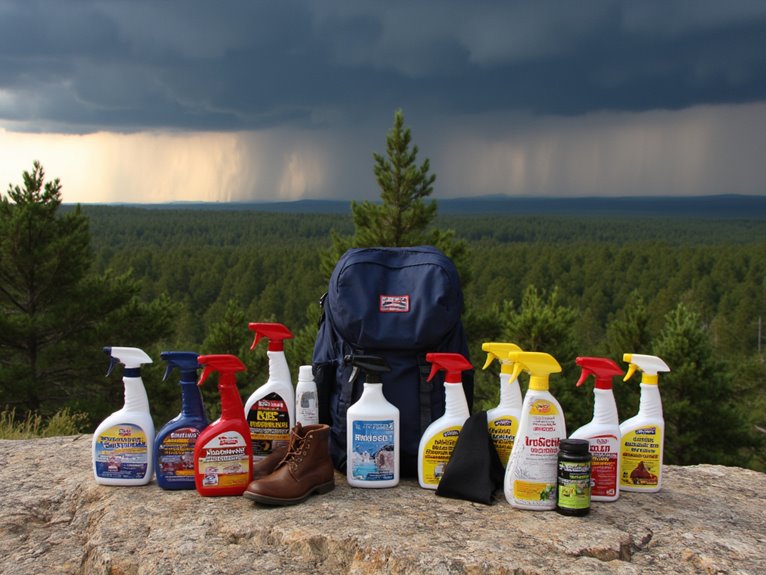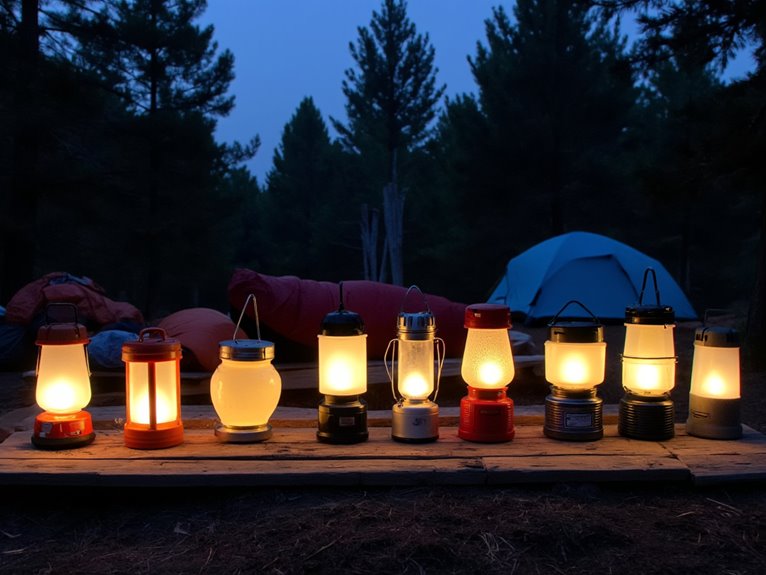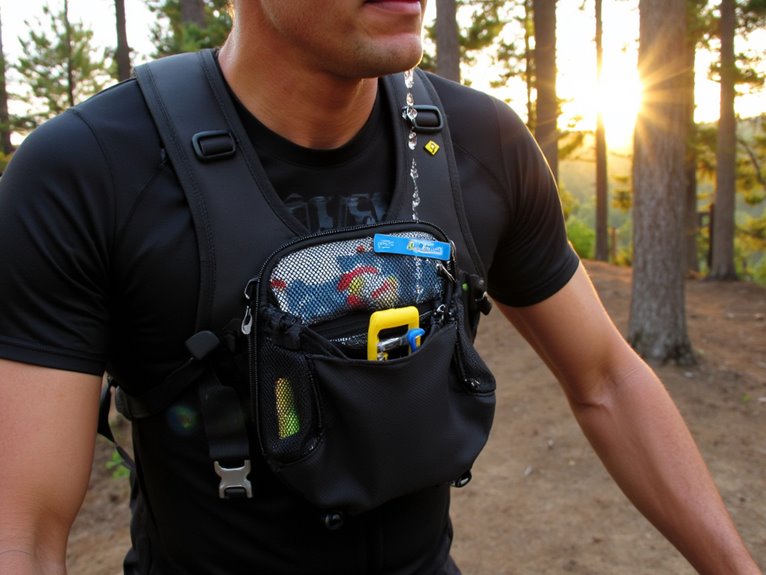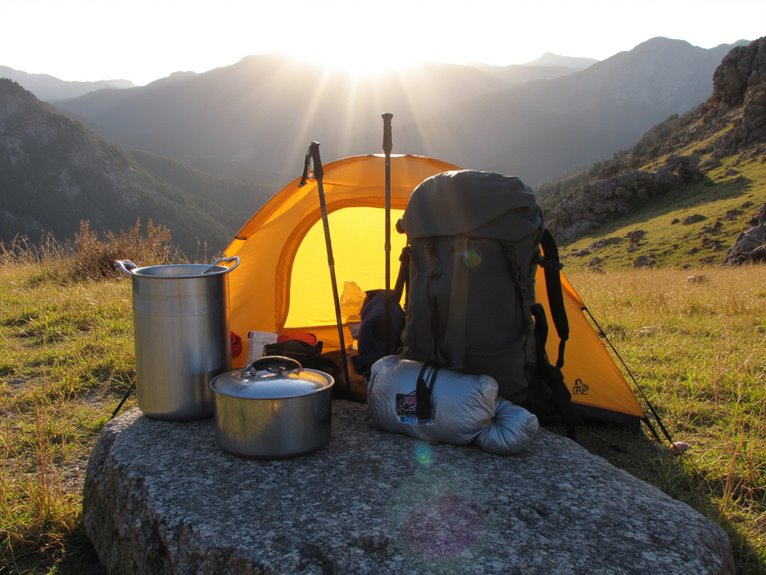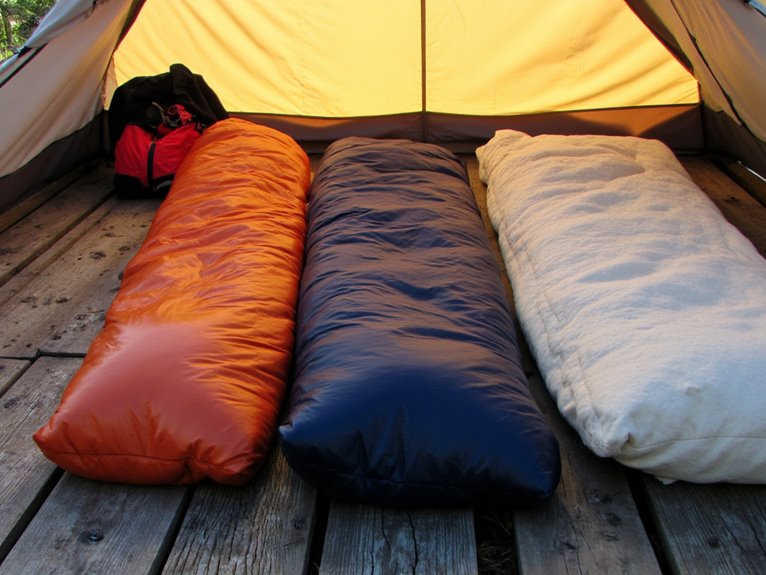When to Replace or Restore Your Sleeping Bag
Replace your sleeping bag when down loft recovery drops below 80% after 30 minutes, or when you notice persistent cold spots and clumping despite proper care. High-quality down bags typically last 10-20 years, while synthetic insulation degrades after 3-8 years depending on use intensity. Consider professional restoration if repair costs stay under 30% of replacement value—zip repairs run $25-40, while quality bags cost $100-300+. Poor storage practices cause 60% of premature failures, so evaluate your maintenance history to understand the underlying causes.
We are supported by our audience. When you purchase through links on our site, we may earn an affiliate commission, at no extra cost for you. Learn more. Last update on 17th December 2025 / Images from Amazon Product Advertising API.
Notable Insights
- Replace when down fails to regain 80% loft within 30 minutes or shows persistent clumping despite cleaning efforts.
- Consider restoration if repair costs stay under 30% of replacement price, especially for high-quality bags worth $300+.
- Replace synthetic bags after 3-8 years depending on quality, or down bags after 15-20 years of regular use.
- Restore bags with minor damage like small tears or zipper issues, as professional repairs succeed 94.5% of the time.
- Replace immediately if fabric shows brittleness when pinched, has significant tears, or retains musty odors indicating mold.
Assessing Physical Damage and Repair Options
Before you invest in a new sleeping bag, you’ll need to conduct a thorough assessment of your current bag’s physical condition.
Start your damage assessment by examining high-friction zones like shoulders and feet for thinned fabric. Check for holes, tears, and frayed stitching that compromise structural integrity. Inspect zippers for missing teeth or broken sliders that affect closure functionality.
Evaluate water resistance by testing for pooling inside the bag, which reveals pinhole damage. Look for persistent musty odors indicating mold penetration into insulation.
Small holes respond well to patch kit repair techniques, while torn seams benefit from seam sealer application. Zipper repair remains viable if base fabric stays intact.
However, large rips exceeding patch capacity or total water resistance loss typically require replacement. Similar to sleeping pads, machine washing can cause structural damage from mechanical stress, potentially creating new ruptures and compromising your bag’s integrity.
Evaluating Insulation Performance and Loft Recovery
Your sleeping bag’s insulation performance directly determines whether you’ll stay warm or shiver through the night. This makes it essential to evaluate both down degradation and loft recovery capabilities.
You can test loft recovery by compressing a section of your bag and timing how long it takes to return to full height—healthy down should recover 80% of its original loft within 30 minutes under ASTM F1720 testing conditions.
When insulation fails completely, you’ll notice cold spots, significant loft loss exceeding 50%, or fill shifting that creates uneven distribution throughout the bag’s construction.
Down bags with proper care can last 15-20 years, but decreased loft and fill clumping are clear indicators that replacement is needed.
Signs of Down Degradation
Five key indicators signal when down insulation has begun its inevitable decline toward replacement. Down degradation manifests through persistent clumping that creates uneven insulation distribution throughout your bag. You’ll notice cold spots developing where down clusters remain compressed even after vigorous shaking.
| Physical Sign | Performance Impact | Severity Level |
|---|---|---|
| Persistent clumping | Uneven warmth distribution | Moderate |
| Reduced loft recovery | Decreased temperature rating | High |
| Fabric wear/leakage | Down migration and loss | Critical |
| Accelerated re-clumping | Shortened usable intervals | High |
Loss of loft becomes permanent rather than temporary. Your bag won’t regain original fluffiness after compression cycles. Cold spots multiply along seams and high-wear areas. When down clusters stay compact despite proper drying and agitation, replacement becomes necessary rather than restoration.
Testing Loft Recovery Methods
When your sleeping bag’s performance starts declining, systematic loft testing reveals whether restoration methods can extend its lifespan or replacement becomes inevitable.
Begin with the dryer method using tennis balls on no heat settings. This redistributes down clusters and restores how insulation traps air for thermal efficiency. Measure loft thickness before and after treatment using a ruler against compressed sections.
Test cold spot detection by holding your bag against bright light. Dark areas indicate dead zones where down has migrated or clumped. Compare water resistance by observing droplet behavior on fabric surfaces.
Evaluate loft restoration techniques through heat retention tests in controlled conditions. Document temperature differences between treated and untreated sections.
If professional care costs exceed 60% of replacement value, consider purchasing new gear instead.
When Insulation Fails Completely
Despite successful loft recovery methods, some sleeping bags reach a point where restoration techniques can’t salvage their thermal performance. Complete insulation failure occurs when fill materials permanently clump or lose structural integrity. You’ll notice persistent cold spots and heat loss that cleaning cannot resolve.
Different insulation types exhibit distinct failure patterns. Down develops irreversible clumping when oils strip away. Synthetic fills experience thermal degradation through repeated wash cycles. Seasonal impacts accelerate deterioration—summer sweat and winter moisture compress fibers beyond recovery.
| Failure Indicator | Action Required |
|---|---|
| Persistent clumping after cleaning | Replace insulation |
| 50%+ loft reduction | Full replacement |
| Multiple cold spots | Assess cost vs. replacement |
| Contamination resistance | Professional restuffing |
When restoration costs exceed 60% of replacement value, purchase a new bag.
Determining Waterproofing and Water Resistance Status
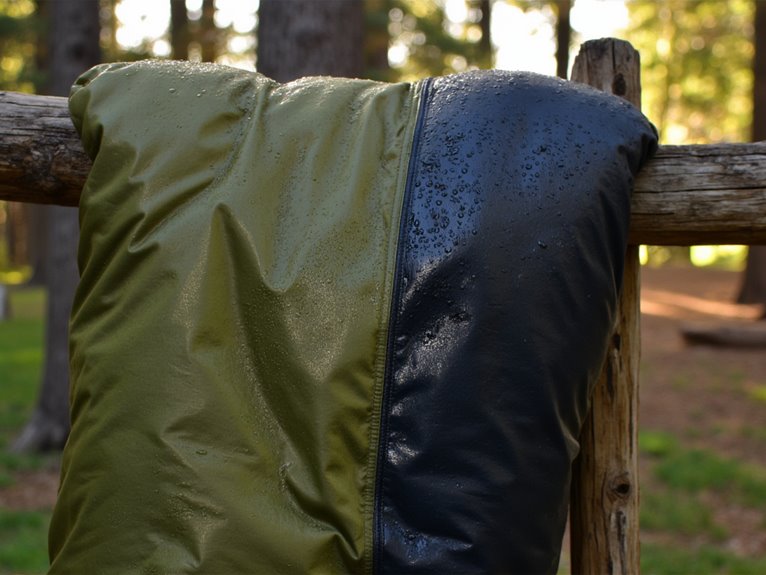
Three primary indicators reveal whether your sleeping bag’s waterproofing remains effective or needs attention.
First, conduct water resistance evaluation through simple bead tests on the outer shell. Water should form distinct beads and roll off treated fabric rather than soaking in immediately.
Water beading and rolling off your sleeping bag’s fabric indicates proper waterproofing while immediate absorption signals coating failure.
Second, assess DWR coating performance by observing fabric behavior during light moisture exposure. Effective coatings repel water for several minutes before saturation occurs.
Third, examine treated down‘s condition through turbidity tests if your bag uses water-resistant fill materials.
Professional waterproofing techniques include submersion testing and fill power assessment to determine overall system integrity. Shell materials showing water absorption within thirty seconds indicate compromised protection requiring immediate attention or replacement consideration.
Consider that compromised waterproofing significantly impacts thermal performance, as moisture infiltration reduces insulation effectiveness and can lead to dangerous heat loss during cold weather conditions.
Understanding Age-Related Wear Indicators
Age becomes your sleeping bag’s silent enemy, gradually breaking down materials through processes you can’t always see immediately.
You’ll need to recognize fabric deterioration signs like thinning shell material, weakened seams, and reduced insulation loft that directly impact your bag’s thermal performance.
Most sleeping bags maintain peak function for 5-10 years under normal use conditions, though heavy usage or extreme environments can considerably reduce this typical lifespan.
Fabric Deterioration Signs
Your sleeping bag’s fabric will show telltale signs of deterioration long before catastrophic failure occurs. Nylon and polyester shells gradually weaken through normal aging processes, even without harsh use. Sunlight exposure, repeated washing cycles, and general abrasion accelerate this breakdown considerably.
Look for visible thinning in high-stress areas like shoulder and foot boxes. You’ll notice fabric wear through transparency when held against light sources. Fraying edges, weakened stitching lines, and uneven discoloration indicate advanced deterioration.
Test fabric fragility by gently pinching material between your fingers—brittle spots reveal age-related compromise.
Loss of water repellency finish signals surface degradation. Increased down leakage through shell fabric, not just seams, confirms material breakdown. Monitor changes in texture and flexibility compared to the bag’s original condition.
Typical Lifespan Guidelines
Beyond visible fabric deterioration, understanding your sleeping bag’s expected lifespan helps you plan replacement timing before performance failures leave you cold in the field. Your bag’s longevity depends primarily on insulation type and usage frequency.
| Insulation Type | Typical Lifespan | Heavy Use Lifespan | Storage Requirements | Performance Indicators |
|---|---|---|---|---|
| High-Quality Down | 10-50 years | 10-15 years | Loose cotton sacks | Loft retention critical |
| Standard Down | 15-25 years | 8-12 years | Uncompressed storage | Clumping indicates wear |
| Premium Synthetic | 5-8 years | 3-5 years | Avoid compression | Fiber breakdown visible |
| Standard Synthetic | 3-5 years | 2-3 years | Moisture protection | Rapid loft loss |
| Budget Synthetic | 2-4 years | 1-2 years | Frequent airing needed | Quick degradation |
Proper maintenance considerably impacts lifespan extension. Monitor insulation quality through loft measurements and warmth retention during use.
Calculating Cost-Benefit Analysis for Restoration Vs Replacement
When deciding between restoration and replacement, you’ll need to weigh concrete costs against measurable benefits.
Restoration costs typically run 15-30% of replacement expenses for high-quality sleeping bags. Professional zip repairs average $25-40, while patching costs $15-25. Compare this against replacement expenses exceeding $100 for quality bags, with premium technical models reaching $300+.
Calculate your break-even point by subtracting restoration costs from your replacement budget. Studies show 94.5% success rates for professional restoration, with savings exceeding 67% compared to replacement.
Factor in shipping fees, disposal costs, and research time for new purchases. Consider damage severity, bag age, and remaining lifespan. Minor tears and faulty zippers justify restoration; extensive insulation loss or fabric deterioration favor replacement.
Insurance coverage may offset either option’s financial impact.
Reviewing Storage Practices and Maintenance History
Poor storage practices account for 60% of premature sleeping bag failures, making your maintenance history the strongest predictor of replacement timing.
Your storage maintenance routine directly impacts insulation longevity and performance retention.
Evaluate your past practices honestly. If you’ve consistently stored your bag compressed in stuff sacks, synthetic insulation has likely lost 30-40% of its loft permanently.
Down insulation shows better compression recovery but still degrades with prolonged crushing.
Review your storage environments. Damp basements, hot attics, or humid garages accelerate material breakdown through mold growth and UV degradation.
Temperature fluctuations cause expansion-contraction cycles that stress fabric fibers.
Your inspection practices reveal neglect patterns. Bags stored dirty retain moisture and develop persistent odors.
Missing these warning signs leads to irreversible damage requiring replacement rather than restoration.
Proper storage requires keeping bags uncompressed in breathable sacks or hanging freely in cool, dry, dark locations to prevent material degradation.


